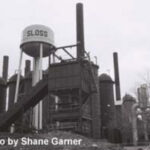When a single location has spawned a magnitude of human suffering, it is likely to be psychically disturbed for a long time – especially if that suffering culminated in approximately 60 deaths in less than 100 years.
Residual emotions get absorbed into the very atmosphere; violent actions are repetitively replayed; and unresolved ‘business’ continues to consume souls that refuse to, or cannot for whatever reason, move on to the next dimension.
Such is the case with Birmingham’s legendary Sloss Furnace. In fact, plenty of experts rate this massive relic of the Industrial Age as a premier American paranormal hotspot — they often describe the site as among the most troubled they have researched.
Experienced news crews have raced off the property the second when through shooting required footage, visibly agitated.
Birmingham police files retain dozens upon dozens of reports of peculiar goings-on at the Furnace. These range from tales of apparitional sightings, to odd noises, to feelings of being stalked, to inexplicable movement of objects, to past assaults by what seem to be supernatural forces.
In addition (strangely enough and despite the presence of several entities), it is apparently a solo personality causing most of the commotion. What, exactly, is it about the Furnace and that particular manifestor that produces all this otherworldly upheaval?
To begin with, we must of course examine the early history of the facility. It is no exaggeration to say that Sloss Furnace was instrumental in making the ‘Magic City’ a globally famous production center of top-quality steel and iron.
Col. James Withers Sloss, a successful Alabama merchant, railroad magnate, and entrepreneur, decided to erect the Furnace upon noting the rich and varied mineral deposits of the Birmingham region. Construction on the gargantuan east-side structure was initiated in 1881. The sleepy burg of Birmingham blossomed as industry and commerce sprang up around the venture – called ‘the monster’ or ‘the old lady’ – and its west-side competitor, Alice Furnaces.
Birmingham steel rapidly turned out to be a highly demanded commodity, used to create everything from the mushrooming skyscrapers of New York to the new-fangled horseless carriages beginning to stream out of Detroit.
Through several expansions and modernizations (including a comprehensive rebuilding in 1929) until its closing in 1971, Sloss Furnace provided employment and a sense of identity for thousands of North Alabamians. Its huge smokestacks reaching skyward reaffirmed B-town as an industrial giant of the New South.
As its output zenith concluded, the complex was donated to the city and converted into an industrial-revolution museum in 1983. It now serves as an arts center, boasts a grand concert/entertainment hall and a habitually sold-out Halloween haunted-house tour, and best of all, has recently found fresh national status as a designated Historic Landmark. ‘The old lady’ is still providing work and income for Birmingham, and the firm of Sloss Industries, Inc. chugs on as a diversified company, though it no longer actually owns the Furnace.
But now, on to the downside of Sloss’ saga with its unnatural curse and the account of a certain phantom who regularly makes its unique attendance felt.
At the outset, a number of steel-pushers, as they were called, were glad to be employed there and proud of the company’s contribution to the revitalization of North Alabama subsequent to the Civil War.
But others were less enthused, as they were required to dwell on the grounds and thus endure arbitrary coercion back to the line when deemed necessary by their higher-ups.
They received payment in company script, which was good exclusively at company stores to purchase company merchandise for sale at company prices. The hours could be excruciatingly lengthy, the work backbreaking, and fatigue a perpetual threat – not to mention the heat in the facility, which sometimes climbed up to 120 degrees Fahrenheit in the summer.
Understandably, there were those dissatisfied with these features of the job but with minimal employment about, there was not much of an alternative for the masses – especially for African-Americans and immigrants gravitating toward Alabama.
In spite of everything, these trials were somehow bearable … unless you worked the graveyard shift in the latter part of the 1800’s. James Robert Wormwood, known derisively as ‘Slag’, ruled the roost then. (His nickname refers to the waste by-product of molten iron and was an appropriate moniker, as shall be made plain.) It is purportedly the infuriated spirit of Slag that is responsible for the preponderance of the tumult at Sloss Furnace.
During his tenure as manager, Slag obsessed about impressing the Furnace’s upper administration with ever-increasing production on his watch. He simply didn’t care about any attendant human suffering amongst his men. From 1886 to the turn of the century, Slag allegedly drove, harangued, and abused his men to the point of desperation on their part. A skeleton crew of about 150 struggled, under Slag’s slave driving, to keep the Furnace fed and roaring at greater-than-peak-performance.
Unnecessary risk-taking was de rigueur, safety precautions ignored, and men labored to the point of exhaustion. Accidents and fatalities, 47 of them out of Sloss’ 60, repeatedly occurred under Slag’s regime. He brutalized those under him and they, in turn, roundly hated him.
In October of 1899, Slag was ostensibly looking over the upper section of the tallest blast furnace, when those below spied him suddenly hurtling into a vat of boiling ore under the catwalk. His body was gone in seconds. The official explanation asserted that Slag either slipped or lost consciousness from the fumes and fell. Whispers flew that the sadistic Slag was actually dragged, dead or alive, to the Sloss heights and tossed into oblivion. They noted that he had never before inspected the furnace tops.
Either way, Slag is, shall we say, displeased with his gruesome and unexpected end and he makes his wrath felt.
Overnight work ceased as a result of the fatality, but Slag unmistakably persists in trying to control Sloss Furnace once the sun sinks and before it rises, during his prior shift hours.
Weird lights bob around. Blast whistles go off by themselves. Stairs and abandoned hallways creak to ethereal footsteps. A random mist drifts down the catwalks of the main floor. Various people touring the facility insist they have heard a male voice angrily ordering them back to work. Some have actually seen the badly burned visage of an irate man gesticulating at them.
Both sightseers and employees have received abrupt, disembodied shoves from behind, once up a stairway. Most frightening of all, a security guard from a couple of decades ago claimed to have sustained an attack by a fire-scarred, enraged-looking creature that pounded on him with its fists.
So if you perchance tour the Furnace, be sure to stay with your group and strictly within the designated areas. Avoid the vat and the catwalk where Slag met his fate. Do not call out for ‘Jim’ or ‘Mr. Wormwood,’ and especially not ‘Slag,’ as the less well informed sometimes do.
You might not like the result.


